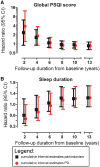Sleep and risk of parkinsonism and Parkinson's disease: a population-based study
- PMID: 31038176
- PMCID: PMC6911221
- DOI: 10.1093/brain/awz113
Sleep and risk of parkinsonism and Parkinson's disease: a population-based study
Abstract
Sleep disturbances may signal presence of prodromal parkinsonism, including Parkinson's disease. Whether general sleep quality or duration in otherwise healthy subjects is related to the risk of parkinsonism remains unclear. We hypothesized that both worse self-reported sleep quality and duration, as well as a longitudinal deterioration in these measures, are associated with the risk of parkinsonism, including Parkinson's disease. In the prospective population-based Rotterdam Study, we assessed sleep quality and duration with the Pittsburgh Sleep Quality Index in 7726 subjects (mean age 65 years, 57% female) between 2002 and 2008, and again in 5450 subjects between 2009 and 2014. Participants were followed until 2015 for a diagnosis of parkinsonism and Parkinson's disease. Outcomes were assessed using multiple modalities: interviews, physical examination, and continuous monitoring of pharmacy records and medical records of general practitioners. We used Cox regression to associate sleep, and changes in sleep over time, with incident parkinsonism and Parkinson's disease, adjusting for age, sex, education and smoking status. Over 64 855 person-years in 13 years of follow-up (mean: 8.4 years), 75 participants developed parkinsonism, of whom 47 developed Parkinson's disease. We showed that within the first 2 years of follow-up, worse sleep quality {hazard ratio (HR) 2.38 per standard deviation increase [95% confidence interval (CI 0.91-6.23)]} and shorter sleep duration [HR 0.61 per standard deviation increase (95% CI 0.31-1.21)] related to a higher risk of parkinsonism. Associations of worse sleep quality [HR 3.86 (95% CI 1.19-12.47)] and shorter sleep duration [HR 0.48 (95% CI 0.23-0.99)] with Parkinson's disease were more pronounced, and statistically significant, compared to parkinsonism. This increased risk disappeared with longer follow-up duration. Worsening of sleep quality [HR 1.76 per standard deviation increase (95% CI 1.12-2.78)], as well as shortening of sleep duration [HR 1.72 per standard deviation decrease (95% CI 1.08-2.72)], were related to Parkinson's disease risk in the subsequent 6 years. Therefore, we argue that in the general population, deterioration of sleep quality and duration are markers of the prodromal phase of parkinsonism, including Parkinson's disease.
Keywords: PSQI; cohort; epidemiology; sleep.
© The Author(s) (2019). Published by Oxford University Press on behalf of the Guarantors of Brain. All rights reserved. For Permissions, please email: journals.permissions@oup.com.
Figures


Comment in
-
Schlechter Schlaf kündigt Parkinson an.MMW Fortschr Med. 2019 Nov;161(Suppl 3):19. doi: 10.1007/s15006-019-1086-3. MMW Fortschr Med. 2019. PMID: 31713796 Review. German. No abstract available.
References
-
- Abbott RD, Ross GW, White LR, Tanner CM, Masaki KH, Nelson JS, et al.Excessive daytime sleepiness and subsequent development of Parkinson disease. Neurology 2005; 65: 1442–6. - PubMed
-
- Al-Qassabi A, Fereshtehnejad SM, Postuma RB. Sleep disturbances in the prodromal stage of parkinson disease. Curr Treat Options Neurol 2017; 19: 22. - PubMed
-
- Ascherio A, Schwarzschild MA. The epidemiology of Parkinson’s disease: risk factors and prevention. Lancet Neurol 2016; 15: 1257–72. - PubMed
-
- Beekman AT, Deeg DJ, Van Limbeek J, Braam AW, De Vries MZ, Van Tilburg W. Criterion validity of the Center for Epidemiologic Studies Depression scale (CES-D): results from a community-based sample of older subjects in The Netherlands. Psychol Med 1997; 27: 231–5. - PubMed
Publication types
MeSH terms
LinkOut - more resources
Full Text Sources
Medical

